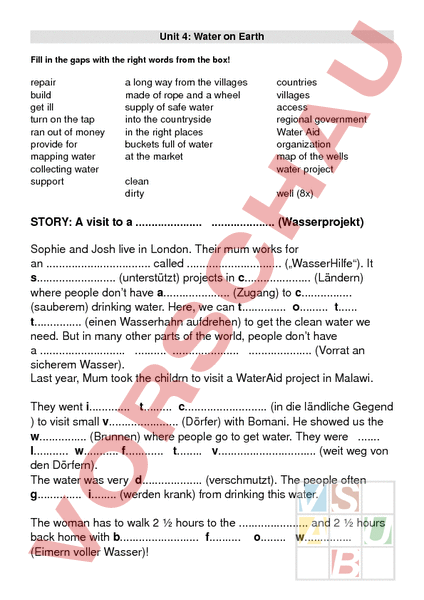Arbeitsblatt: TopDeck 2 Unit 4 Vocab
Material-Details
Lückentext Chunks und Wörter aus Story Unit 4
Englisch
Wortschatz
6. Schuljahr
2 Seiten
Statistik
99604
1044
14
02.06.2012
Autor/in
L W
Land: Schweiz
Registriert vor 2006
Textauszüge aus dem Inhalt:
Unit 4: Water on Earth Fill in the gaps with the right words from the box! repair build get ill turn on the tap ran out of money provide for mapping water collecting water support long way from the villages made of rope and wheel supply of safe water into the countryside in the right places buckets full of water at the market clean dirty countries villages access regional government Water Aid organization map of the wells water project well (8x) STORY: visit to . (Wasserprojekt) Sophie and Josh live in London. Their mum works for an . called („WasserHilfe). It s. (unterstützt) projects in c. (Ländern) where people dont have a. (Zugang) to c (sauberem) drinking water. Here, we can t o. t t. (einen Wasserhahn aufdrehen) to get the clean water we need. But in many other parts of the world, people dont have . . (Vorrat an sicherem Wasser). Last year, Mum took the childrn to visit WaterAid project in Malawi. They went i. t. c (in die ländliche Gegend to visit small v (Dörfer) with Bomani. He showed us the w. (Brunnen) where people go to get water. They were . l. w. f t v. (weit weg von den Dörfern). The water was very d. (verschmutzt). The people often g i (werden krank) from drinking this water. The woman has to walk 2 hours to the and 2 hours back home with b. f o w. (Eimern voller Wasser)! WaterAids builds .s. And the r. g. (regionale Regierung) builds .s, too. But the regional government r o. o. m. (haben nicht mehr genug Geld gehabt). Thats why some villages have .s and some dont. And thats problem. You need to know where there are s already. Then you can plan to b. (bauen) new ones i t r p. (an den richtigen Orten). Water Aid need to create m. o. t w (Karte mit den Brunnen). This is called m w. (Wasser kartografieren). WaterAid uses the GPS satellite positioning system for it. Josh is surprised that the new is only m o. r a w. (aus Seil und einem Rad gemacht). Bomani explains to him that they always use materials that the people in the village can find easily. They need to be able to r. (reparieren) the .s themselves. Now, c (Wasser holen) only takes 10 minutes for the woman. The water is clean and people dont get ill. Now, the people have more time to work and grow food. They often sell vegetables a t. m. (auf dem Markt). The money they earn helps them to p f (versorgen) their children. Josh and Sophie learned how important it is to have a. t. c w (Zugang zu sauberem Wasser).
